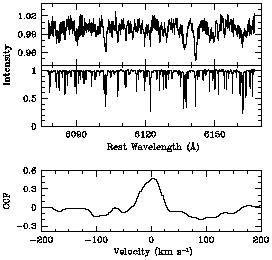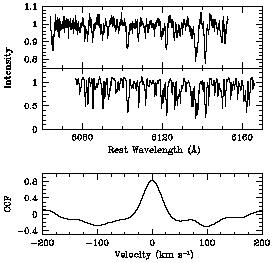


One of the central, unanswered questions is whether SSCs are genuine young globular clusters. Thus far, the arguments advanced in favor of this idea have been largely inconclusive because the observational evidence is subject to different interpretations. Perhaps the most pertinent piece of missing information is the mass of the clusters. The total stellar mass is very difficult to estimate reliably, since virtually all of the observables trace the young, massive stars, which comprise only a small fraction of the total mass for a normal IMF. It would be highly advantageous to bypass this complication by obtaining a direct, model-independent measurement of the dynamical mass.
Using the HIRES spectrograph mounted on the Keck 10 m telescope, Ho & Filippenko (1996a, b) recently acquired high-dispersion (FWHM = 7.9 km s-1) optical spectra of the central cluster in NGC 1705 (NGC 1705-1) and of cluster ``A'' in NGC 1569 (NGC 1569-A), both of which have fairly reliable sizes determined from HST images (O'Connell et al. 1994; Meurer et al. 1995). Since these clusters have ages of 10-20 Myr, a substantial population of cool supergiants contributes to the integrated spectrum at visual wavelengths, and Ho & Filippenko demonstrate that it is feasible to derive the line-of-sight velocity dispersion from the weak metal lines detected in both objects. Figure 4 illustrates the cross-correlation technique of Tonry & Davis (1979) applied to the two clusters.

|

|
Figure 4. Measurement of the stellar velocity dispersions in cluster ``A'' of NGC 1569 (left; Ho & Filippenko 1996a) and in the central cluster of NGC 1705 (right; Ho & Filippenko 1996b). The top panel in each case shows the cluster spectrum, the middle panel the template star used to derive the velocity dispersion, and the bottom panel the cross-correlation function between the cluster and star. The width of the main velocity peak of the cross-correlation function is related to the velocity dispersion. |
The line-of-sight velocity dispersions are found to be
 * =
15.7 ± 1.5 and 11.4 ± 1.5 km s-1 for NGC 1569-A and
NGC 1705-1,
respectively. Assuming that the clusters are gravitationally bound (as seems
quite likely considering their compactness), spherically symmetric, and
isotropic systems, the dynamical mass is given by M = 3
* =
15.7 ± 1.5 and 11.4 ± 1.5 km s-1 for NGC 1569-A and
NGC 1705-1,
respectively. Assuming that the clusters are gravitationally bound (as seems
quite likely considering their compactness), spherically symmetric, and
isotropic systems, the dynamical mass is given by M = 3 *2 R/G
according to the virial theorem, where R is the effective gravitational
radius. As a first-order approximation, let us assume R =
Rh, the half-light radius.
Meurer et al. (1995)
recently reanalyzed the images of
O'Connell et al. (1994)
and determined Rh = 1.9 ±
0.2 and
0.9 ± 0.2 pc for NGC 1569-A and NGC 1705-1, respectively. The
corresponding
masses [(3.3 ± 0.5) x 105 and (8.2 ± 2.1) x
104 M
*2 R/G
according to the virial theorem, where R is the effective gravitational
radius. As a first-order approximation, let us assume R =
Rh, the half-light radius.
Meurer et al. (1995)
recently reanalyzed the images of
O'Connell et al. (1994)
and determined Rh = 1.9 ±
0.2 and
0.9 ± 0.2 pc for NGC 1569-A and NGC 1705-1, respectively. The
corresponding
masses [(3.3 ± 0.5) x 105 and (8.2 ± 2.1) x
104 M ] and mass densities
(1.1 x 104 and 2.7 x 104 M
] and mass densities
(1.1 x 104 and 2.7 x 104 M pc-3) agree
remarkably well with the
typical values of evolved globular clusters in the Galaxy. Galactic globular
clusters have an average mass of 1.9 x 105 M
pc-3) agree
remarkably well with the
typical values of evolved globular clusters in the Galaxy. Galactic globular
clusters have an average mass of 1.9 x 105 M (Mandushev, Spassova, &
Staneva 1991),
and their sizes (and hence densities) are similar to those of
the young clusters. Both clusters have absolute visual magnitudes near -14,
and their estimated ages are 10-20 Myr. In 10-15 Gyr, they will
fade by 6 to 7 mag in the V band
(e.g., Bruzual & Charlot
1993),
reaching
MV = -7 to -8 mag, in excellent agreement with the
peak of the nearly
universal luminosity function of globular cluster systems
(< MV >
(Mandushev, Spassova, &
Staneva 1991),
and their sizes (and hence densities) are similar to those of
the young clusters. Both clusters have absolute visual magnitudes near -14,
and their estimated ages are 10-20 Myr. In 10-15 Gyr, they will
fade by 6 to 7 mag in the V band
(e.g., Bruzual & Charlot
1993),
reaching
MV = -7 to -8 mag, in excellent agreement with the
peak of the nearly
universal luminosity function of globular cluster systems
(< MV >  -7.3 mag;
Harris 1991).
Moreover, if mass
loss during advanced stages of stellar evolution will not significantly reduce
the cluster masses, the mass-to-light ratios of NGC 1569-A and NGC 1705-1
will be M/LV = 2.5-6.3 and 0.7-1.6
(M/LV)
-7.3 mag;
Harris 1991).
Moreover, if mass
loss during advanced stages of stellar evolution will not significantly reduce
the cluster masses, the mass-to-light ratios of NGC 1569-A and NGC 1705-1
will be M/LV = 2.5-6.3 and 0.7-1.6
(M/LV) , respectively,
again in reasonable agreement with the observed range for Galactic globular
clusters [0.7-2.9
(M/LV)
, respectively,
again in reasonable agreement with the observed range for Galactic globular
clusters [0.7-2.9
(M/LV) ;
Mandushev et al. 1991].
This finding implies that, to a first approximation, the stellar IMF
of the clusters is similar to that of typical globular clusters in the
Milky Way.
;
Mandushev et al. 1991].
This finding implies that, to a first approximation, the stellar IMF
of the clusters is similar to that of typical globular clusters in the
Milky Way.
The apparent similarity between the stellar content of SSCs and globular
clusters has important consequences for the IMF of starbursts. In the
well-known case of M82,
Rieke et al. (1980,
1993)
have argued that the star
formation is biased toward high-mass stars; specifically, the IMF evidently
truncates below ~ 3 M . This provocative result, however, has
been hotly debated (e.g.,
Scalo 1986,
1987;
Zinnecker 1996).
Since SSCs appear to be
the basic building blocks or ``cells'' of star formation in starbursts, and,
as shown above, at least some SSCs seem to be genuine young globular
clusters, the implication is that starburst regions may well have an IMF
similar to that of globular clusters, which are richly populated with low-mass
stars (e.g.,
Paresce et al. 1995).
At this meeting, Moffat, Zinnecker, and
others have presented evidence that some nearby starburst regions evidently
also have fairly normal IMFs.
. This provocative result, however, has
been hotly debated (e.g.,
Scalo 1986,
1987;
Zinnecker 1996).
Since SSCs appear to be
the basic building blocks or ``cells'' of star formation in starbursts, and,
as shown above, at least some SSCs seem to be genuine young globular
clusters, the implication is that starburst regions may well have an IMF
similar to that of globular clusters, which are richly populated with low-mass
stars (e.g.,
Paresce et al. 1995).
At this meeting, Moffat, Zinnecker, and
others have presented evidence that some nearby starburst regions evidently
also have fairly normal IMFs.